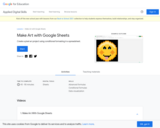
Students learn to use Google Sheets to make pixel art.
- Subject:
- Arts and Humanities
- Material Type:
- Lesson Plan
- Provider:
- Provider Set:
- Google for Education
- Author:
- Google Applied Digital Skills
- Date Added:
- 08/30/2021

Students learn to use Google Sheets to make pixel art.
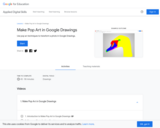
Learn how to create Pop Art using Google Drawings.
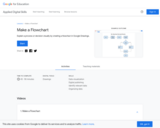
Learn how to create Flowchart using Google Drawings.
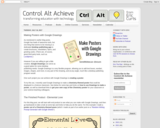
Share some great Google Drawing practices with your students through this amazing post from Control Alt Achieve.

This lesson explores the question: Why did the Founders find it necessary to provide protections for slavery in the US Constitution?
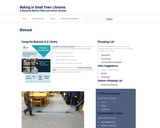
BluTrack is a two lane, flexible racetrack. BluTrack is both fun and educational. Bring the racetrack to your library with the Blutrack racing system! See how to implement BluTrack activities in your library. This guide includes: A list of what you’ll need, tips for choosing a theme, ideas to run a library activity, and a DIY (“How To”) guide for the youth.
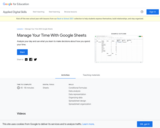
Create a schedule using Google Sheets.
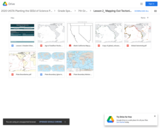
A Google Drive folder with lesson plan and accompanying resources studying volcano and earthquake trends follows similar patterns as plate boundaries.

Dr. Masha Shukovich is a neurodivergent person with acute synesthesia that she describes as her superpower. Synesthesia essentially means that their brain interprets words and narratives as moving images (similar to videos); numbers as colors; tastes as images, shapes, colors and sounds; and so on. For example, she can taste or smell a recipe before actually making it, simply by reading it or hearing it read out loud, which has greatly enriched their experiences as a chef, an artist, a storyteller and their current fictional/magical realism novel, The Taste of Names.

The Coherence Map from AchieveTheCore.org maps out the Common Core mathematics standards in a tree format. Select any math standard and see the prerequisite standards as well as what it is a prerequisite for. Each standard has attached tasks, progressions, and assessments.
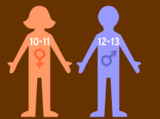
Per Utah Code 53G-10-402 parental consent is required prior to instruction in this content.This lesson explains the changes that boys in Upper Elementary and Middle School can expect as they enter puberty and suggestions on how to respond to these changes. It also explains the purpose and process of intercourse in regards to reproduction. The materials included are designed for boys taught either by a certified medical professional or in the home by parents/guardians. This lesson contains:Images from Advocates for YouthA video from the Puberty Workshop on eMediaCover Image
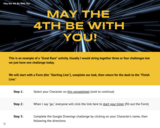
Dig into this great example of a Great Race program with a Star Wars flair.

Almost one quarter of the people in the world are Muslim. But how much do we really understand Muslims here in America? Maysa Kergaye, a Muslim woman who calls Utah home, but has lived in multiple countries and US states, opens up the conversation about what it means to be Muslim, her experiences as a Muslim woman in America , and particularly as a minority in Utah.

Here is a lesson plan on today's farming for students to learn and explore using Microsoft Excel.
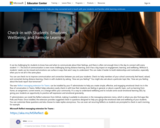
Learn how to create check-ins with your students in Microsoft Teams.
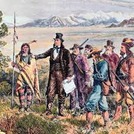
This lesson will engage students in understanding the impact Mormon pioneer settlers had on Native American tribes living in Utah. Students will also understand and appreciate the role that Mormon pioneer settlers had on the eventual settling of Utah. Students will be assessed by creating an Apple Pages project wherein they demonstrate their understanding of the two issues. Students are asked to create an essay including images about the impact Mormon pioneer settlement of Utah had on Native Americans. Image Credit: North Wind Picture Archives

For over 20 years, a summer program for gifted adolescents at Western Kentucky University has offered an arts-integrated history course on Nazi Germany and the Holocaust. The course concludes with students working as a group to create a large mural on the Holocaust. In this way, students use the power of art to deal with their own emotions as well as to educate others. The murals from the past 20 years went on a traveling display in Kentucky to engage a broader audience in thought-provoking conversation on the topic. In this video collection, hear the stories of a Holocaust survivor and the son of a Holocaust survivor who are involved with the program, learn how students in the program decided on a theme for their mural, and learn how one teacher incorporates the arts into Holocaust history lessons.

In this media-rich lesson plan, students explore how to keep their digital lives safe, spot cyber scams, and learn the basics of coding from NOVA Labs. The lesson begins with students watching the Cybersecurity 101 video and discussing the online safety measures that they currently take. Next, students make predictions about online safety best practices, complete the Level 1 challenges of the NOVA Cybersecurity Lab, and compare the best practices from the game with their predictions. Students reconvene for direct instruction on the best practices and key computer science terms, and then finish the Cybersecurity Lab game. Finally, students complete the video quizzes with short-response discussion questions and can work on the Cybersecurity stories as homework reading assignments.

In this media-rich lesson plan from NOVA Labs, students use short videos to explore the following topics: what energy is, how it can be converted into useful forms, and why some sources are running low. Students also investigate alternative energies and how energy is stored and transported. The research challenge allows students to use scientific data to design their own renewable energy plans for a real cities and compete with others to produce the most power. Students use maps, graphs, and weather data to assess the energy potential of various locations and benefits of using renewable energy in different regions of the country.

Explore the evidence for evolution through phylogenetics with this lesson plan from NOVA's Evolution Lab. First, students consider and discuss how we understand and organize the biodiversity that exists on Earth. Students are then introduced to phylogenetic trees and practice building them with the Build a Tree interactive. In Build a Tree, students use both morphology and DNA analysis to identify relationships between species. Next, students explore speciation and shared ancestry with the Deep Tree interactive. As an interactive tree of life, Deep Tree helps students understand evolutionary history on Earth. Discussion questions and video quizzes allow educators to assess student understanding.